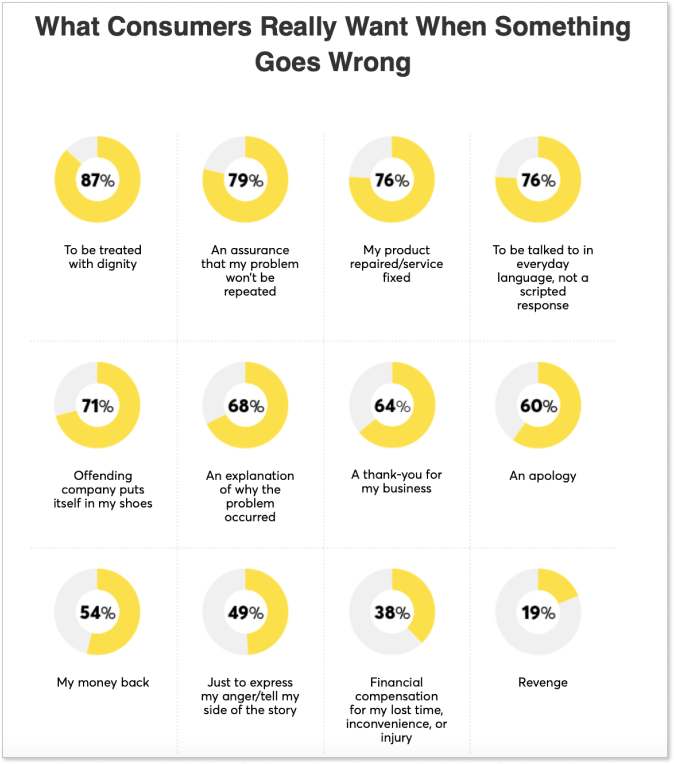8 Bad Customer Service Examples from Real Life
Here's a list of unbelievably bad customer service examples that happened in real life. Check it out to NEVER act this way towards your clients!
Written by Tetiana Shataieva

It was one of those autumn days when it rained cats and dogs. Having forgotten my umbrella at home, I walked down the street shivering from the cold and searching for a place to hide. There was a luxury hotel along the road, but I doubted I could come inside as I wasn’t their client or even a target audience for that matter.
The porter saw my confused look and opened the doors for me. I hesitantly asked if I could just wait out the rain in the lobby? He answered with a smile: “Of course, come inside.” I didn’t order anything at the bar, much less did I book a room, but their attitude touched me deeply.

A few months later, the magazine I worked for was organizing a conference for foreign entrepreneurs. Can you guess which hotel I recommended for the event?
This is an example of good customer service and its positive consequences. But not all companies have an approach like this one, and in the long run, it backfires on them and results in frustrated customers.
“It takes years to win a customer and only seconds to lose one.”
Catherine DeVrye
I’ve collected for you a list of 8 bad customer service examples to learn from. It can help you see a clear picture of how you should never act and what to do if something goes wrong.
What is bad customer service?
You may not be aware of how to explain it, but you know exactly when you come across one.
Bad customer service usually leaves a client angry, sad, and dissatisfied. It happens when a business fails to meet one’s expectations. Respondents describe that the most irritating pain points of bad customer service are:
- Not being able to get a live person to talk to
- Rude or incompetent customer service agents
- Long time on hold
- Request to repeat the same story again
- Useless proposed solution
- Pushy salespeople
After all, in case of poor customer service, consumers want to be treated with dignity, be assured that the problem won’t repeat itself, that the issue was fixed, and so on.

How can bad customer service actually damage your business?
Clients equal money. Losing the former leads to losing the latter as well. Okay, you got it.
But what’s so horrifying about losing a client or two? Companies around the globe lose and find thousands of clients on a daily basis.
The problem is that an average dissatisfied consumer is going to tell between 9-15 people about their bad experience. And around 13% will tell more than 20 people. So each time you lose one client because of bad customer service, multiply this number by at least 9.
And then if you do nothing about it, things get only worse (ha, that’s what my dentist says about caries). More and more people abandon the brand, and consequently, the business is gradually dying.
So, let’s dive right in and grab some valuable insights!
8 examples of bad customer service
1. Threatening a client that something bad might happen if they don’t buy your service
Lucy Thorpe, a digital marketing specialist, shared this story of a bad customer experience.
Once she took her youngest daughter to get her eyes checked. Fortunately, the little girl turned out fine but for several years now, Lucy has been receiving emails telling her that she must bring her daughter back for a checkup.
What’s worse, the longer she does nothing, the more irritating letters she gets. The whole message behind these mail attacks is that by ignoring them the woman is risking her daughter’s health.
For me, it sounds like a scene from a horror movie. In the next episode, an ophthalmologist from the clinic will burst into the apartment and gouge everyone’s eyes out with the phrase, “We warned you.”

Needless to say, this tactic did not in any way motivate Lucy to go back to that clinic. Manipulating a person’s fear for their or their loved ones’ health is just mean.
Takeaway: use positive emotions instead of fear
Having bought your product out of fear, they are unlikely to associate your company with pleasant emotions. And it will definitely not increase loyalty or satisfaction. Moreover, there is a possibility that after a while, when a person calms down, they will refuse the service anyway and leave a bad review. Do you need that?
Even if you sell insurance and this potential client of yours may indeed one day regret not buying your service, you should not ever threaten or scare them.
So instead, offer your product or service in a friendly way, and mention how a prospective client can benefit from it. But if they say “No”, please, let them go.
2. Thoughtlessly following the protocol while it only makes things worse
Two unaccompanied children, 7 and 9 years old, were on the flight to Orlando returning from their grandparents. When the weather turned bad, the Frontier airplane had to change its course, landing in Atlanta. But don’t panic, the attendant took care of the kids and stayed with them in a hotel for the night. So, from the clients’ safety perspective, everything was done just right.
Why do we call it an example of a bad customer experience? Well, the Frontier company didn’t consider it necessary to care for the children’s parents. They were cluelessly waiting at the Orlando airport with no idea about the whereabouts of their children. They found out later that the flight had been diverted. But no one told them if the kids were safe, brought to the hotel, and who accompanied them.
The customer service team at the Orlando airport was unhelpful and couldn’t provide any updates. No wonder, the parents were freaked out and furious about the situation. Fortunately, one of the kids borrowed a phone and messaged their parents.
But the problems didn’t stop there. After such an unpleasant experience, the clients decided to make a complaint to the Frontier airline company and to the news. Guess what was the organization’s reaction?
Nope, they didn’t apologize or take responsibility for the mishap. Instead, Frontier followed the protocol and said something like: “We understand how an unexpected delay caused by weather can be stressful for a parent and our goal is to help passengers get to their destinations as quickly and safely as possible.” This message can hardly smooth out nasty feelings and perfectly demonstrates what a bad customer service example looks like.
Takeaway: stay proactive and think a few steps ahead
At its core, customer service means taking care of your client’s well-being. With all your actions, you should send them a clear message “We are here for you”.
Moreover, when it comes to support, it’s very important to think a few steps ahead along the entire customer journey. The company managed to solve the existing problem but failed in proactive thinking which implied finding parents and sharing the updates.
When bad things happen it’s exactly the time to show your client-centric attitude and do everything in your power to soften the negative experience and calm unhappy customers down. Often it’s about the ability to communicate, show empathy, or apologize elaborately. And it looked like Frontier had nothing to apologize for.

3. Making clients wait too long for a response
Andrew Karaman has shared his story of bad customer service on Quora and told how he shipped a few radiation detectors from the UPS store. Since the instruments were fragile and quite expensive, he decided to insure the shipment for $10,000. It cost him over a hundred dollars.
Three days later Andrew received an email from the staff telling him that the package had been damaged, and the detector was broken. They also attached photos of the broken instrument. A few months passed before they finally got it fixed and sent the man an invoice for $360.
Since Andrew insured the package, he counted on a refund for the repair. He visited the UPS website to learn about the filing insurance claim process. There was no information provided. Then the man went to the local UPS store looking for answers, but the staff suggested contacting UPS Customer Service.
As there was no live chat on the website to get in touch with the customer support team quickly, Andrew sent an email describing what happened. The facility started a month-long run-around, asking for more information and photos.
At some point, the client got worn out from waiting and gave a call to the support.
From there it got even worse. After being bounced from one customer service representative to another and having to re-explain the story three times, he was eventually put in touch with the person who refused to honor the insurance claim. There were no alternatives like appealing the company’s decision or another opportunity to prove that the claim was truthful.
I won’t go into details here, but just imagine yourself in this man’s shoes. No wonder, he stated, “I’ll certainly never ship with them again”.

Takeaway: ensure a fluid and fast way to communicate with people
Enterprises often hide their contact details behind fill-in forms as they have a huge flow of users, and it is almost impossible to assist everyone efficiently and on time. But when clients experience troubles with your product or service, it’s in your interest to resolve the issue ASAP.
It all starts with a fluid and easy-to-use communication channel between you and your clients. Live chat is a way to stay in touch with clients so that they don’t have to look for your email address, or phone number or run to the local store.
On top of that, some live chat tools like HelpCrunch offer a knowledge base feature within the live chat software. It’s a self-help option that allows users to find information on your website by themselves.
If UPS had a comprehensive knowledge base with helpful articles, Andrew wouldn’t even have to write or make numerous phone calls to the support office. He would be able to find the necessary information on the website instead. And who knows, maybe the story would have had a happy ending without negative reviews.
4. Creating problems rather than solving them
This is a tale of terrible customer service told by my friends Darina and Marina.
One summer day they decided to travel to Mexico, see the pyramids at Teotihuacan, drink tequila, and try their luck in Taxco. Believe it or not, everything went just as planned until the night before the return flight from Cancún.
Since the girls visited Mexico for the first time, they decided to use the Booking airport shuttle service. In Mexico City, it worked just great. The taxi driver met my friends at the airport and brought them to a hotel safe and sound. But let’s get back to the night of the mishap.
Picture this: you are having the time of your life in a Cancún nightclub with your friend, you are calm and relaxed. Tomorrow you have a flight back home after an amazing three-week vacation in Mexico.
Your plane leaves at 1:30 pm, and the shuttle from your hotel to the airport is booked and paid for. The cab will come to pick you up at 10:40 am. And there is no single reason to worry about.
Then suddenly at 11 pm, you receive a message. Something like: “Unfortunately, we got overbooked and there is no driver available to cover the service. We will start the refunding process.”
What would your reaction be? My friends got mad and started texting with a customer service department to finally realize that nothing could be done. The next morning they had to look for a taxi on the street, negotiate the price without knowing a single word in Spanish, and withdraw cash from an ATM (there was an exorbitant commission!)
Darina and Marina were furious and promised to never use the service again.

Takeaway: solve a problem instead of creating a new one
If something unexpected happens, and you provide poor service resulting in customer complaints, consider how else to solve the client’s problem instead of creating a new one.
In such circumstances, it’s not so much about the money as about the fact that the girls urgently needed a car to get to the airport on time. So if it were your taxi company, what would you do? For instance, you could order a cab from another taxi firm, covering all additional travel expenses. Or, if it’s not an option, you could take your own car and go pick up your clients.
This way you would be remembered for your generous actions and win loyal customers. Plus, you would never appear on the list of horrible customer service examples, but only great ones.
5. Thinking a customer is being sneaky to get something for free
This is another example of bad customer service that happened to a group of friends who stood on the street in front of the restaurant waiting for a table. One of the fellows had type 1 diabetes.
At some point, his hands began to shake. The friends immediately assumed that the guy was going into diabetic shock, which, fortunately, can be prevented. For this, he needs to get a fast infusion of sugar, from a glass of orange juice, let’s say.
One of the friends frantically asked the bartender for a glass of juice. “Our friend is diabetic, he needs some orange juice ASAP, ” she said. The server looked at the girl then at their friend’s shaking hands, and blurted: “Nice act.”

It’s easy to guess what happened next. The guy with diabetes went into shock. He began to shake uncontrollably and fainted on the floor. His friends called an ambulance. The paramedics came, took him outside, and helped to get his blood sugar level back to normal.
Takeaway: lend a helping hand to your clients even if you doubt their honesty
Of course, there are people who lie to get something for free or skip the line. Because of such unpleasant incidents, business owners try to be careful and not give the cheater a chance. But while being cautious, they miss some important cases when a client needs real help.
The best strategy is to lend a helping hand even if you are not sure about the credibility of the story told. Otherwise, you risk being placed on the list of poor customer service stories just like this one and get stormed by negative customer feedback.
I remember once I went to a local grocery store. There was an old woman who left the shop and then came back in two minutes announcing that the cashier forgot to give her eggs.
“But ma’am, you said that you don’t need eggs,” answered the server. Without getting into an argument with the old lady, the cashier brought her eggs to the doorstep, put them in the woman’s bag, and said quietly “Here, take it. This is a gift.”
6. Making sensitive information about the client revealed to the entire room
The most common case here is when a server says out loud: “Your credit card was denied!” Instead, a cashier can say something like “I’ve been having trouble with the machine frequently, can we try another card?”
But this story of bad customer service is about something much more sensitive than a denied card. Mike DeMobe shared his worst service experience ever.
The man was flying on the plane and had to go to the bathroom. Unfortunately, it was not allowed to wait in line in front of the lavatory. So he had to return to his seat in the middle of the plane. And every time someone jumped in front of him he couldn’t get to the bathroom first.
Having just one kidney, the man had more trouble trying to hold it in. As soon as he would see the person come out he would hustle up there and every time someone got there before him.
At some point, the passenger was reaching a crisis point when it was almost impossible to endure. So he tried to stay near the lavatory, slowly walking back and forth hoping to get a jump on the next opportunity.
The stewardess was constantly telling the man to get back to his seat. Mike pulled the stewardess aside and quietly explained his situation. Surprisingly, she was rude and answered: “Return to your seat and wait!”
One of the passengers clearly heard Mike’s attempt to explain the situation to the stewardess and offered the man his seat. He was much closer to the lavatory and, embarrassment aside, Mike needed to get there, so he agreed immediately.
When the stewardess saw Mike in another seat she freaked out. She told him that it wasn’t his seat and asked the steward to help her get Mike back to his seat. At this point, almost everyone in the 7 rows knew what was happening.
Several passengers were pleading his case and saying “Just let him wait, he’s not bothering anyone!” The stewardess didn’t care. She said, “Return to your seat, or you will be taken into custody!” The man asked: “Why? I just need to go to the bathroom.”
As Mike walked back he thought there was nothing he could do to hold it much longer. Then suddenly a woman walked out of the bathroom and asked the man “Are you still waiting to use the lavatory?” He nodded. The woman told everyone waiting to get to the bathroom: “This poor man has been trying to use the lavatory for 30 min, and he only has 1 kidney!” Mike was allowed to skip the line and use the bathroom.

It’s not that he didn’t appreciate the woman’s gesture, but it was embarrassing that the entire plane knew his situation. If it were not for the flight attendant’s negligence, Mike would not have been in such a situation when the entire plane learned about his health issues.
Considering this story of the worst customer service, no wonder, the airline went out of business about a year later.
Takeaway: protect clients’ sensitive information
Taking care of how customers feel implies protecting their sensitive information. So if they have their card denied or quietly explain about some health issues, make sure you do everything possible to assist them and keep it private. Before the negative impact on your company kicks in.
Feeling embarrassed is one of the people’s greatest fears. In such situations, we might feel weird, stupid, ugly, or worthless. No doubt a client will not feel like coming back to the place where they felt embarrassed ever again.
7. Performing work like a robot without being responsible for the end result
Sometimes people like robots just do their job without thinking twice. And if things go wrong, they say, “I’ve done my job, the rest doesn’t concern me.” Usually, it leads to bad customer service reviews.
Cara Koscinski placed an online order for a $70 cake at Publix supermarket. The occasion was her son’s graduation day. Cara typed a phrase into the space marked as “Cake message option”: “Congrats Jacob! Summa Cum Laude Class of 2018!”
“Summa Cum Laude” translates as “with the highest distinction” in Latin. However, Publix’s computer system flagged the word “cum” as vulgar.
Interestingly, Koscinski included the definition of “Summa Cum Laude” in a box for “Special instructions”. Unfortunately, it didn’t help.
On Saturday, the chocolate and vanilla cake, adorned with green, blue, and yellow flowers, was delivered to a graduation party. The message on the cake said: “Congrats Jacob! Summa — Laude Class of 2018.”

The woman was shocked. “My son was humiliated!!! I seriously couldn’t make this crap up!!!!” Koscinski wrote on Facebook.
This story was covered by BBC, The Washington Post, and a bunch of other media outlets. Quite a PR, ha?
In turn, Publix gave Koscinski a $70 refund, and a gift card, and offered to remake the cake. But the woman didn’t need this: “No. You only graduate once. Maybe I should have just gotten him his favorite mint chocolate chip ice cream instead.”
Takeaway: let your staff be proactive and responsible for the end result
It’s important to teach your staff to take responsibility for the end result.
In this case, the duty of the confectioner is not just to bake a delicious cake according to the specified recipe, but to control if the inscription on the cake makes sense. The duty of the one who accepts the order is to find out the details of what exactly the client had in mind, and what message they expect to see on the cake.
Let your employees be proactive, embracing their customer service skills, asking questions, clarifying details, and offering their views on how a product or service can be improved. Then a positive result will not be long in coming.
8. Not giving a refund when a customer requests it after bad service
This is the story of Jainam Shah and the MoviePass service.
Probably, I have to start with the fact that the theatrical subscription company has a 1.4 rating on Google Play. Yet, let’s take a closer look at one particular case of bad customer service that happened with a MoviePass client.
It sounds so tempting, you pay just $9.95 a month and can watch one movie a day in any theater of your choice. Basically, you can watch 30 movies a month for a price of just 10 dollars.
Jainam Shah signed up for the service in August 2017. A week later he received an email from the company saying that he would get a MoviePass card around the beginning of September. So he waited. But there was no card sent to him.
The man initiated a support ticket regarding the card using the company’s website. They answered him with a canned response saying that they were just overloaded. So it might take some extra time to deliver the card.
As Jainam didn’t hear back from them for about a week, he tried to contact the company representatives via live chat in the app. But it was completely pointless because no live person ever replied. Each time he got the same canned response as before.
Then, on the 22nd of September, he received an email from the organization stating “Your personalized MoviePass card has been ordered and should arrive in about 5 business days.” That’s when the customer got really excited as eventually after almost 1.5 months he was about to receive his card.
Another week passed by with no sign from the company. Almost losing his faith, the man filed for support again. And received the same canned response.
At this point, Jainam didn’t want to deal with the company and its bad service any longer, so he requested a refund.
What they responded was a surprise. Suddenly a live agent emailed him back and promised to send a replacement card, asking to confirm Jainam’s current shipping address.
“Great! I’ve gotten a replacement card sent out to your confirmed address. Please let us know once you receive it so that we can activate it on your account.”
Well. Can you guess the end of the story? At the time of writing an online review, a month has passed, and Jainam still hasn’t received his card. And they didn’t refund his money.
One sentence with which he ended the review goes like this: “F*** Off MoviePass..!”

Takeaway: make a refund when a client demands it, or you can lose much more
It looks like the company was a total fraud feeding clients with promises and meanwhile collecting their money. But let’s talk about what is instructive in this example of bad customer service?
Surely, making a refund is an unpleasant process but essential when you face angry customers demanding their money back. It can cost you much more, say, your reputation and thousands of prospective clients, if you refuse to return the payment.
From this point of view, I love Uber. Just yesterday they charged me the cancellation fee, however, I canceled the ride long before the driver was even heading my way. By just following a simple procedure, I got my refund. No need to call a live agent or prove oneself right. That’s one of the reasons why I love this app.
Being a client-centric company, we at HelpCrunch always try to meet the buyer’s needs with a human touch as well. If someone shows discontent, our agents are ready to offer free access to the tool for about a month or even make a refund in extreme cases. After that, we usually send a customer satisfaction survey to find out how a person feels – we appreciate honesty!
Bottom line
Even if you are the best customer-oriented company, sometimes things don’t go according to plan. That’s why it’s important to be ready and know how to react in case of unprecedented situations. So that your business is never included in examples of bad customer service like this one.
How to ensure yourself against mishaps then? T
To begin with, provide a reliable and fast communication channel between you and your clients. If something goes wrong, your clients will always be able to turn for your help. The easiest way to always stay in touch with users is a multichannel live chat. HelpCrunch is customer service software that allows you to support your clients 24/7. Just start a 14-day free trial now to provide excellent support to your customers. No strings attached.





